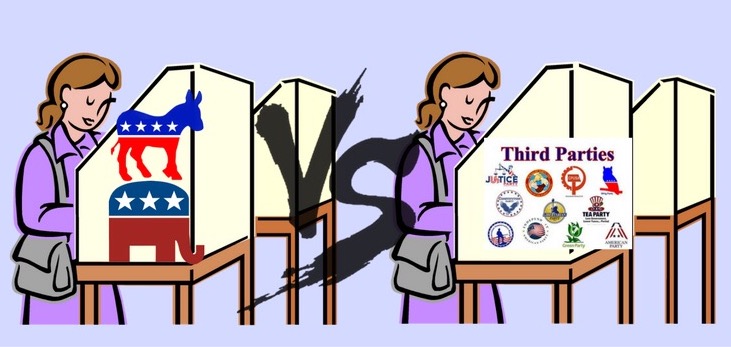It’s the first week after your 17th birthday. You’ve passed your driving test and now you can take an amazing Instagram-worthy picture and brag over your younger friends. In doing so, it is also your first time dealing with the dreaded Department of Motor Vehicles: not fun stuff. To top it all off, you can now register for voting. When you get the form, four options are listed: Republican Party, Democratic Party, Undecided, and Other. For most people, there are only two obvious choices: Republican and Democratic. Such a trend alludes to a large problem in our society: The American Two-Party System.
The Two-Party System is a situation where two political parties hold the most representation in the government and have nearly absolute power. Currently, nearly every Senator, Congressman, and Governor belongs to either the Republican or Democratic Party. Even most state-level positions are dominated by the two parties. Some could say that these parties simply have the best policies that encompass the desires of most Americans, which is why they are the primary competition in so many elections. And while it is true that the policies of each party are liked by many, it is also true that the American populace is so diverse and varied that it is impossible to stuff everyone’s viewpoints into two main parties and the outliers in a few other ones. Instead, the real cause of the American Two-Party System is that of societal pressures and government policies.
Have you ever heard the phrase, “vote for the lesser of two evils”? Or “don’t waste your vote on someone besides a Democrat or Republican”? How about the term “third party”? Maybe I have forgotten where democracy was supposed to be limited to two choices, but I find these statements absurd and it leads our public policies to be skewed into arguments for control. In George Washington’s Farewell Address, he states that, “However [political parties] may now and then answer popular ends, they are likely in the course of time and things, to become potent engines, by which cunning, ambitious, and unprincipled men will be enabled to subvert the power of the people and to usurp for themselves the reins of government, destroying afterwards the very engines which have lifted them to unjust dominion.” Free thought is fueled by options — not choices. The main parties have been able to manipulate public opinion into supporting them on one topic and then keeping their support for their entire agenda. Nothing scares a politician more than someone thinking for themselves. There has been a grand trickery of the public that voting for a “third party” (the name itself shows that there is not as much seriousness given to them) will accomplish nothing. On the contrary, it already has. Look at the 2016 Presidential Election; specifically, the media and the polls. Unlike that of the 2012 election, there was an immense uptick in the votes put towards parties and candidates not Republican and Democratic, as well as the frequency of articles covering such “third parties”. Less people are giving into the reign of the American Two-Party System, which is good. At the same time, it means politicians need to adapt their methods: not so good.
Gerrymandering is a method in which political factions adjust the boundaries of voting districts in order to unfairly favor their party. In America, none other than the Democrats and Republicans are known for employing this method. By creating strange and curved districts, each party has been able to contort the lines in order to have a majority of voters in a section and win a few more Congressional seats.
Our district—NJ District 5—is a very bad example of gerrymandering by the Republicans. The election of Josh Gottheimer in the most recent race was notably historic, as the Democratic Party has only held this seat for 17 years in total since the end of the Civil War: 17 out of 150 years. This nonstop battle for voting districts has been seen by both parties all over the country and the lines get contorted stranger and stranger each election cycle. To make matters worse, there is nothing requiring Congressmen to step down due to the absence of term limits. This has been a highly debated topic recently as many Congressmen are reaching the 40 and even 50 year mark of their power, making them career politicians. Thomas Jefferson believed that, “a little rebellion now and then is a good thing,” but us Americans have stayed silent as politicians grow their power infinitely.
In the current political climate, nearly nobody supports the Democratic or Republican Party entirely. The parties act as if they are the only rightful competitors in our modern American political environment, but the public wants change. In a survey after the 2016 Presidential Election, a majority of respondents stated that they believed the main goal of the Democratic Party was to be opposing Republicans, instead of pushing their liberal values. One of the biggest tactics for gaining votes is to bring the other major party down and then enforce that the Two-Party System will never fall. In order to inspire change, politicians need to see more than just low voting turnout—there needs to be larger voter turnout for 3rd party candidates. As high school students, we are the future of America and will soon be able to vote. It is time that we research third party options. Some of you may have even voted in the Gubernatorial Election this past November. Vote Libertarian, or Green, or Constitution, or whatever you desire. The most important thing is that you don’t vote on a Democrat or Republican if you don’t truly support what they are running for.
Mark Salzman
staff writer
Graphic: Maraea Garcia

